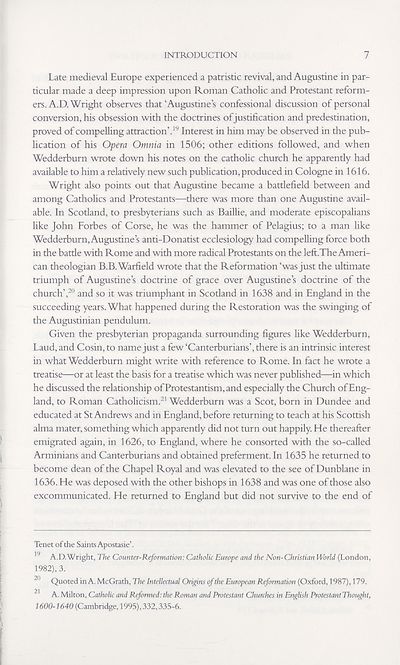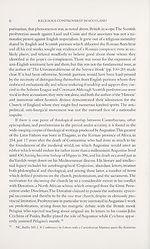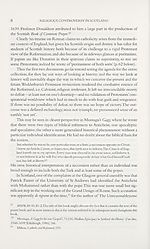Series 5 > Religious Controversy in Scotland 1625-1639
(22) Page 7
Download files
Complete book:
Individual page:
Thumbnail gallery: Grid view | List view

INTRODUCTION
7
Late medieval Europe experienced a patristic revival, and Augustine in par¬
ticular made a deep impression upon Roman Catholic and Protestant reform¬
ers. A.D. Wright observes that ‘Augustine’s confessional discussion of personal
conversion, his obsession with the doctrines of justification and predestination,
proved of compelfing attraction’.19 Interest in him may be observed in the pub¬
lication of his Opera Omnia in 1506; other editions followed, and when
Wedderburn wrote down his notes on the catholic church he apparently had
available to him a relatively new such publication, produced in Cologne in 1616.
Wright also points out that Augustine became a battlefield between and
among Catholics and Protestants—there was more than one Augustine avail¬
able. In Scotland, to presbyterians such as Baillie, and moderate episcopafians
like John Forbes of Corse, he was the hammer of Pelagius; to a man like
Wedderburn, Augustine’s anti-Donatist ecclesiology had compelling force both
in the batde with Rome and with more radical Protestants on the left.The Ameri¬
can theologian B.B. Warfield wrote that the Reformation ‘was just the ultimate
triumph of Augustine’s doctrine of grace over Augustine’s doctrine of the
church’,20 and so it was triumphant in Scotland in 1638 and in England in the
succeeding years. What happened during the Restoration was the swinging of
the Augustinian pendulum.
Given the presbyterian propaganda surrounding figures like Wedderburn,
Laud, and Cosin, to name just a few ‘Canterburians’, there is an intrinsic interest
in what Wedderburn might write with reference to Rome. In fact he wrote a
treatise—or at least the basis for a treatise which was never published—in which
he discussed the relationship of Protestantism, and especially the Church of Eng¬
land, to Roman Catholicism.21 Wedderburn was a Scot, born in Dundee and
educated at St Andrews and in England, before returning to teach at his Scottish
alma mater, something which apparently did not turn out happily. He thereafter
emigrated again, in 1626, to England, where he consorted with the so-called
Arminians and Canterburians and obtained preferment. In 1635 he returned to
become dean of the Chapel Royal and was elevated to the see of Dunblane in
1636. He was deposed with the other bishops in 1638 and was one of those also
excommunicated. He returned to England but did not survive to the end of
Tenet of the Saints Apostasie’.
19 A.D.Wright, The Counter-Reformation: Catholic Europe and the Non-Christian World (London,
1982), 3.
20 Quoted in A. McGrath, The Intellectual Origins of the European Reformation (Oxford, 1987), 179.
21 A. Milton, Catholic and Reformed: the Roman and Protestant Churches in English Protestant Thought,
1600-1640 (Cambridge, 1995), 332,335-6.
7
Late medieval Europe experienced a patristic revival, and Augustine in par¬
ticular made a deep impression upon Roman Catholic and Protestant reform¬
ers. A.D. Wright observes that ‘Augustine’s confessional discussion of personal
conversion, his obsession with the doctrines of justification and predestination,
proved of compelfing attraction’.19 Interest in him may be observed in the pub¬
lication of his Opera Omnia in 1506; other editions followed, and when
Wedderburn wrote down his notes on the catholic church he apparently had
available to him a relatively new such publication, produced in Cologne in 1616.
Wright also points out that Augustine became a battlefield between and
among Catholics and Protestants—there was more than one Augustine avail¬
able. In Scotland, to presbyterians such as Baillie, and moderate episcopafians
like John Forbes of Corse, he was the hammer of Pelagius; to a man like
Wedderburn, Augustine’s anti-Donatist ecclesiology had compelling force both
in the batde with Rome and with more radical Protestants on the left.The Ameri¬
can theologian B.B. Warfield wrote that the Reformation ‘was just the ultimate
triumph of Augustine’s doctrine of grace over Augustine’s doctrine of the
church’,20 and so it was triumphant in Scotland in 1638 and in England in the
succeeding years. What happened during the Restoration was the swinging of
the Augustinian pendulum.
Given the presbyterian propaganda surrounding figures like Wedderburn,
Laud, and Cosin, to name just a few ‘Canterburians’, there is an intrinsic interest
in what Wedderburn might write with reference to Rome. In fact he wrote a
treatise—or at least the basis for a treatise which was never published—in which
he discussed the relationship of Protestantism, and especially the Church of Eng¬
land, to Roman Catholicism.21 Wedderburn was a Scot, born in Dundee and
educated at St Andrews and in England, before returning to teach at his Scottish
alma mater, something which apparently did not turn out happily. He thereafter
emigrated again, in 1626, to England, where he consorted with the so-called
Arminians and Canterburians and obtained preferment. In 1635 he returned to
become dean of the Chapel Royal and was elevated to the see of Dunblane in
1636. He was deposed with the other bishops in 1638 and was one of those also
excommunicated. He returned to England but did not survive to the end of
Tenet of the Saints Apostasie’.
19 A.D.Wright, The Counter-Reformation: Catholic Europe and the Non-Christian World (London,
1982), 3.
20 Quoted in A. McGrath, The Intellectual Origins of the European Reformation (Oxford, 1987), 179.
21 A. Milton, Catholic and Reformed: the Roman and Protestant Churches in English Protestant Thought,
1600-1640 (Cambridge, 1995), 332,335-6.
Set display mode to:
![]() Universal Viewer |
Universal Viewer | ![]() Mirador |
Large image | Transcription
Mirador |
Large image | Transcription
Images and transcriptions on this page, including medium image downloads, may be used under the Creative Commons Attribution 4.0 International Licence unless otherwise stated. ![]()
| Scottish History Society volumes > Series 5 > Religious Controversy in Scotland 1625-1639 > (22) Page 7 |
|---|
| Permanent URL | https://digital.nls.uk/127328229 |
|---|
| Description | Over 180 volumes, published by the Scottish History Society, containing original sources on Scotland's history and people. With a wide range of subjects, the books collectively cover all periods from the 12th to 20th centuries, and reflect changing trends in Scottish history. Sources are accompanied by scholarly interpretation, references and bibliographies. Volumes are usually published annually, and more digitised volumes will be added as they become available. |
|---|


